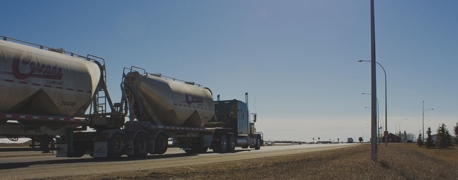That’s Huge! The Dangers of Wide & Oversize Truck Loads

Have you ever been driving down the highway and suddenly found yourself sharing the road with a massive transport truck carrying a “wide load”? These trucks can be intimidating, but they are an essential part of the transportation industry. They are responsible for moving modular homes, industrial equipment, and other oversized cargo from one location to another. In this blog post, we will explore the ins and outs of wide load transport trucks, including what other drivers on the road need to know, the dangers involved, and the laws and rules that govern them.
What Are Wide Load Transport Trucks?
Wide load transport trucks are specialized vehicles designed to carry oversized or overweight loads that cannot fit on a standard truck. These loads typically include modular homes, prefabricated buildings, wind turbine components, industrial machinery, and more. The truck itself is usually a low-bed trailer that has an extended deck to accommodate the width and length of the load. The truck may also have a hydraulic system to lift and lower the cargo for loading and unloading.
What Is the Difference Between Wide Loads and Oversize Loads?
Legally, there is no difference between a wide load and an oversize load. However, the nuanced technical differences can be found in the names of the hauls. Wide loads are measured only by their width; while a standard truck bed is 8 feet wide, any cargo that exceeds 8.5 feet is a wide load. An oversize load is defined as a shipment that exceeds the state limit for weight, width, height, and/or length. Of these factors, width is the most important; most interstate lanes are no wider than 12 feet across, and other road types are typically narrower.
Put simply, not all oversize loads are wide loads, but all wide loads are oversize loads.
While requirements vary from state to state, cargo may qualify as an oversize load if it exceeds:
- 8.5 feet wide
- 8.5 feet high
- 48 feet long
Weight is the only requirement that is mandated by federal laws. The maximum gross vehicle weight (cargo and truck combined) for vehicles traveling on interstate highways, known collectively as the National Network, is 80,000 pounds.
The type of freight carried by oversize load trucks varies, and can include:
- Construction equipment
- Manufacturing equipment
- Agricultural equipment
- Mobile homes
- Boats or trucks
Dangers of Wide Load Transport Trucks
One of the biggest dangers associated with wide load transport trucks is their size. They are much larger and wider than standard vehicles, which can make them difficult to maneuver and control on the road. The driver of a wide load transport truck must have excellent driving skills and experience to navigate the truck safely. Other drivers on the road must also be aware of these trucks and give them plenty of space. They should also avoid sudden lane changes or movements that could startle the driver of the wide load transport truck.
Another danger of wide load transport trucks is the cargo they carry. These loads can be heavy, unwieldy, and difficult to secure properly. If the load is not secured correctly, it can shift during transit and cause the truck to lose control or tip over. This can be a catastrophic event, leading to property damage, injury, or even death. It is essential that drivers and cargo handlers follow strict safety protocols when loading and securing wide loads for transportation.
Common Oversize Load Accidents
The rules and regulations governing wide loads and oversize loads are strict, and for good reason. The consequences of transporting loads that are too wide, tall, or heavy can be severe for truckers and those who share the road with them.
One of the most common accidents that occurs when it comes to oversize loads is when a truck carrying a load that is too tall strikes a bridge that it is trying to pass under. These types of accidents can cause significant delays and dangerous driving conditions including bridge collapse, road shutdowns, and accidents involving multiple vehicles.
That’s what happened in December 2018 when a truck hauling a bulldozer in Akron, Ohio collided with a bridge on the I-76. The collision caused both the interstate and the overpass to be closed for several hours, and a vehicle crashed into the bulldozer after it had fallen off the transport truck.
Another too-tall load caused a bridge to collapse in May 2013; a transport truck carrying an oversize load struck several trusses while crossing the Skagit River on the I-5 bridge in Mount Vernon, Washington. The collision caused the bridge to collapse into the water, sending two vehicles with it. Fortunately, the occupants of the vehicles were recovered safely and suffered only minor injuries. The collapse caused a major disruption in the traffic flow between Seattle and Vancouver.
Laws and Regulations for Wide Load Transport Trucks
Wide load transport trucks are subject to numerous laws and regulations at the federal, state, and local levels. These laws are designed to ensure the safety of everyone on the road, including the drivers of the trucks, other drivers, and pedestrians.
At the federal level, wide load transport trucks must comply with regulations set by the Federal Motor Carrier Safety Administration (FMCSA). These regulations cover everything from driver qualifications and training to vehicle maintenance and safety requirements.
Some of the key requirements for wide load transport trucks include:
- The truck must have a special permit to carry oversized or overweight loads.
- The truck must have the appropriate lighting and warning signs to alert other drivers to the wide load.
- The driver must have a commercial driver’s license (CDL) and specialized training in driving oversized loads.
- The load must be properly secured and distributed on the truck to prevent shifting during transit.
- The truck must follow specific routes and schedules to minimize the impact on other drivers and the environment.
- The truck must employ escort vehicles if the load is wider than 12 feet.
In addition to federal regulations, each state has its own rules and requirements for wide load transport trucks. These rules may include specific weight limits, bridge height restrictions, and route restrictions based on the size of the load. Drivers and cargo handlers must be aware of these rules and comply with them to avoid fines, penalties, or even legal action.
What Is Required to Complete a Wide Load Transport?
Completing a wide load transport requires a lot of planning and preparation. The owner of the transport must obtain a special permit to operate the truck, which often includes minimum insurance levels, and they must plan out the route that the transport will take. Should the route include multiple states, the regulations of each state must be followed, and a permit acquired in each state. These permits are issued on the state level and, according to the Wisconsin Department of Transportation, nearly 5 million permits are granted each year. In addition, owners may need to hire a pilot car to help guide the transport on the road, and they may need to take extra precautions to ensure that the items being transported are secure and won’t shift during transit.
Making the Road Safe for Everyone
Driving a wide load transport is no easy task, but it’s an important job that helps to move large items across the country. If you’re a driver on the road, it’s important to be aware of these trucks and to give them plenty of space when passing. By following the rules and regulations related to wide load transports, we can all work together to keep our roads safe for everyone.


